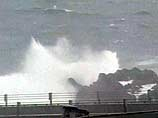Monstrous tsunami likely to hit Russia's Far East
Catastrophic volcano and tsunami disasters take place every 50 or 60 years
Russia's first “Atlas of Natural and Man-Caused Dangers and Emergency Situations” says that Russia's Far Eastern territories, particularly the Kamchatka region and the Kuril islands, might experience the horror of the tsunami disaster, similar to the one that devastated Southeast Asia at the very end of 2004. 
The presentation of the new Atlas took place today in the Russian Emergency Ministry. “Powerful tsunamis like the one that the whole world witnessed at the end of December 2004 occur every 50 or 100 years. Weaker tsunamis are a lot more frequent. The strongest tsunami rocked Russia's shores in 1952, when tidal waves leveled the city of Severo-Kurilsk and killed about 14,000 people. Fifty years have passed since that moment, which brings up the idea that another monstrous tsunami might hit the Far East of Russia again,” the book runs.
Russian scientists believe that a possible tsunami might endanger 14 cities and settlements on the coasts of the Kamchatka Peninsula, Sakhalin and the Primorye region, RIA Novosti reports. Specialists say that the danger of tsunami in the Far East of Russia is closely connected with the high seismicity of the region. Twenty-nine of Russia's 69 active volcanoes are situated in the Kamchatka region and 40 of them can be found on the Kuril islands. Extinct volcanoes are basically situated in Russia's Caucasus.
Weak volcano eruptions occur in the Far East of Russia every year; strong eruptions occur once in several years, whereas catastrophic volcano disasters take place every 50 or 60 years.
Subscribe to Pravda.Ru Telegram channel, Facebook, RSS!




